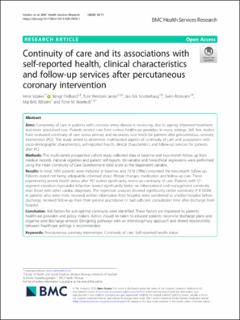| dc.contributor.author | Valaker, Irene | |
| dc.contributor.author | Fridlund, Bengt Gotthard Anton | |
| dc.contributor.author | Wentzel-Larsen, Tore | |
| dc.contributor.author | Nordrehaug, Jan Erik | |
| dc.contributor.author | Rotevatn, Svein | |
| dc.contributor.author | Råholm, Maj-Britt | |
| dc.contributor.author | Norekvål, Tone M. | |
| dc.date.accessioned | 2021-04-28T13:40:02Z | |
| dc.date.available | 2021-04-28T13:40:02Z | |
| dc.date.created | 2020-07-24T14:29:14Z | |
| dc.date.issued | 2020 | |
| dc.Published | BMC Health Services Research. 2020, 20 . | |
| dc.identifier.issn | 1472-6963 | |
| dc.identifier.uri | https://hdl.handle.net/11250/2740222 | |
| dc.description.abstract | Aims
Complexity of care in patients with coronary artery disease is increasing, due to ageing, improved treatment, and more specialised care. Patients receive care from various healthcare providers in many settings. Still, few studies have evaluated continuity of care across primary and secondary care levels for patients after percutaneous coronary intervention (PCI). This study aimed to determine multifaceted aspects of continuity of care and associations with socio-demographic characteristics, self-reported health, clinical characteristics and follow-up services for patients after PCI.
Methods
This multi-centre prospective cohort study collected data at baseline and two-month follow-up from medical records, national registries and patient self-reports. Univariable and hierarchical regressions were performed using the Heart Continuity of Care Questionnaire total score as the dependent variable.
Results
In total, 1695 patients were included at baseline, and 1318 (78%) completed the two-month follow-up. Patients stated not being adequately informed about lifestyle changes, medication and follow-up care. Those experiencing poorer health status after PCI scored significantly worse on continuity of care. Patients with ST-segment elevation myocardial infarction scored significantly better on informational and management continuity than those with other cardiac diagnoses. The regression analyses showed significantly better continuity (P ≤ 0.034) in patients who were male, received written information from hospital, were transferred to another hospital before discharge, received follow-up from their general practitioner or had sufficient consultation time after discharge from hospital.
Conclusion
Risk factors for sub-optimal continuity were identified. These factors are important to patients, healthcare providers and policy makers. Action should be taken to educate patients, reconcile discharge plans and organise post-discharge services. Designing pathways with an interdisciplinary approach and shared responsibility between healthcare settings is recommended. | en_US |
| dc.language.iso | eng | en_US |
| dc.publisher | BMC | en_US |
| dc.rights | Navngivelse 4.0 Internasjonal | * |
| dc.rights.uri | http://creativecommons.org/licenses/by/4.0/deed.no | * |
| dc.title | Continuity of care and its associations with self-reported health, clinical characteristics and follow-up services after percutaneous coronary intervention | en_US |
| dc.type | Journal article | en_US |
| dc.type | Peer reviewed | en_US |
| dc.description.version | publishedVersion | en_US |
| dc.rights.holder | Copyright 2020 The Authors | en_US |
| dc.source.articlenumber | 71 | en_US |
| cristin.ispublished | true | |
| cristin.fulltext | original | |
| cristin.qualitycode | 2 | |
| dc.identifier.doi | 10.1186/s12913-020-4908-1 | |
| dc.identifier.cristin | 1820440 | |
| dc.source.journal | BMC Health Services Research | en_US |
| dc.source.40 | 20 | |
| dc.identifier.citation | BMC Health Services Research. 2020, 20:71 | en_US |
| dc.source.volume | 20 | en_US |

